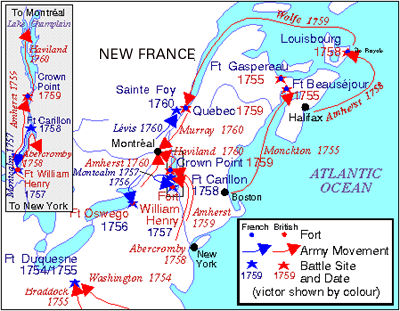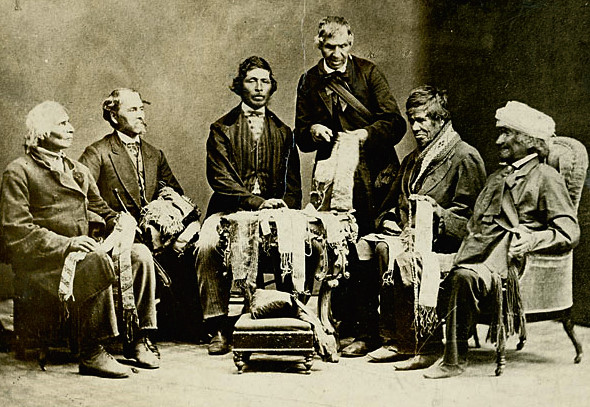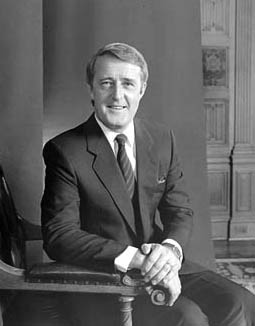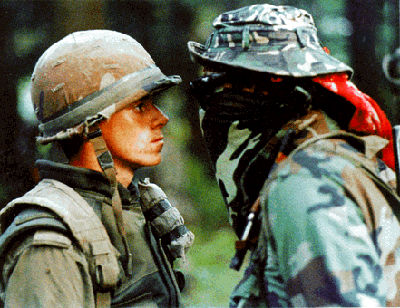Kanesatake Resistance (Oka Crisis)
The Kanesatake Resistance, also known as the Oka Crisis or the Mohawk Resistance at Kanesatake, was a 78-day standoff (11 July–26 September 1990) between Kanyen'kehà:ka (Mohawk) protesters, Quebec police, and the Canadian Army. It took place in the community of Kanesatake, which includes a commons area known as “the Pines.” It is near the Town of Oka, on the north shore of Montreal. Related protests and violence occurred in the Kahnawake reserve, to the south of Montreal. The crisis was sparked by the proposed expansion of a golf course and the development of townhouses on disputed land in the Pines that included a Kanyen'kehà:ka burial ground. Tensions were high, particularly after the death of Corporal Marcel Lemay, a Sûreté du Québec police officer. Eventually, the army was called in and the protest ended. The golf course expansion was cancelled and the land was purchased by the federal government. However, it did not establish the land as a reserve, and there has since been no organized transfer of the land to the Mohawks of Kanesatake. The resistance inspired Indigenous peoples across Canada to take action. It has been linked to the Idle No More movement, as well as demands for an inquiry into missing and murdered Indigenous women in Canada.

-
January 01, 1676

Sulpicians Establish Mount Royal Mission
The Sulpicians, a society of Roman Catholic priests founded in Paris in 1641, establish a mission at Mount Royal on the site of what is now Montreal. Their goal is to convert the local Mohawk, Algonquin and Nipissing people to Christianity.
-
January 01, 1717

Sulplician Mission Moves
The seven-year-old King Louis XV of France grants the Sulpicians nine square miles on the north shore of the St. Lawrence River across from Montreal, on the condition that they build a mission there.
-
January 01, 1721
Sulpicians Seize and Sell Land
The Sulpicians move to the north shore. They build one village for the Mohawk people and another for the Algonquin and Nipissing. But rather than holding the land in trust, as agreed, the Sulpicians retain sole ownwership rights and begin to sell the land to White settlers.
-
January 01, 1761

Mohawks of Kanesatake Petition for Change
With the Battle of the Plains of Abraham in 1759 and the capitulation of Montreal in 1760, Britain conquers New France. In 1761, the Mohawk people of Kanesatake write to government officials in Britain. They describe living under unfavourable rules that threaten their livelihood. They contest their right to the land and ask that they be freed from the authority of the Sulpicians. These demands are ignored. The Mohawk contest their right to the land at least eight times over the next 150 years; all of these requests are rejected.
-
January 01, 1763

Treaty of Paris
The Seven Years’ War between Britain, France and Spain ends with the Treaty of Paris in 1763. France officially surrenders control of Canada to Britain.
-
January 01, 1851

Mohawks of Kanesatake Petition Lord Elgin
TheMohawks of Kanesatake petition Lord Elgin, governor general of Canada, asking him to recognize their right to the land. Their request is denied.
-
January 01, 1853

Reserves Established
The Province of Canada establishes reserves at Maniwaki and Doncaster. It asks the Mohawk and Algonquin people in the area to move there.
-
January 01, 1859

Sulpicians Receive Official Land Title
The Province of Canada passes a bill that is shepherded through the legislature by George-Étienne Cartier. The bill gives the Sulpicians official title to the land. They continue selling the land to White settlers.
-
January 01, 1868

Canadian Government Denies Land Claim
The government of the new Dominion of Canada denies that the Mohawks of Kanesatake's original land grant reserved land specifically for them.
-
January 01, 1877

Place Name Changed from Kanesatake to Oka
The Sulpicians change the name of Kanesatake to Oka.
-
January 01, 1881

Attempt to Relocate the Mohawks of Kanesatake
The federal government offers to move the Mohawks of Kanesatake to a reserve in Gibson, Ontario. About two-thirds of the Mohawk refuse to leave.
-
January 01, 1886

“The Pines” are Planted
Between 1886 and 1897, around 100,000 trees are planted by the Mohawks of Kanesatake under the supervision of Oka village priest Joseph-Daniel Lefebvre. The trees are planted on and at the base of the mountain outside Oka to stabilize the earth after a series of avalanches threatens the town.
-
January 01, 1912

Courts Rule Against the Mohawks of Kanesatake
The Mohawks of Kanesatake’s case over land rights was heard by the Quebec Superior Court in 1910; in 1912, it was heard by the Court of King’s Bench and finally by the Judicial Committee of the Privy Council — Canada’s highest appeals court at the time. The Judicial Committee decides that official title to the land is held by the Sulpicians. Meanwhile, the federal government considers Kanesatake an “interim land base” and not a reserve. It therefore is not covered under the Indian Act. (See also Indigenous Land Claims.)
-
January 01, 1924

Introduction of the Band System
Under the Indian Act, the federal government establishes the system of elected band councils. However, it refuses to recognize Kanesatake as a reserve or as official Mohawk territory. Many Haudenosaunee communities refuse to comply with the band council system until they are forced to do so by the RCMP.
-
January 01, 1936
Sulpicians Sell Land
The Sulpicians sell most of their land in Oka. The Mohawks of Kanesatake are now confined to about 6 km2, compared to the 687 km2 they once held. By the end of the Second World War, the Sulpicians have sold all their remaining land and have left the area. Ownership of the Pines, however, remains unresolved.
-
January 01, 1961

9-hole Golf Course Built
In 1959, the Club de golf Oka begins renting part of the Pines from the town of Oka. A 9-hole golf course is built in the Pines two years later without the consent of the Mohawks of Kanesatake.
-
January 01, 1968

Founding of the Mohawk Warrior Society
The Mohawk Warrior Society is founded as a singing society to carry on traditional Mohawk songs and customs. Inspired by the American Indian Movement (AIM) in the United States, the society advocates armed resistance to defend Indigenous communities and their interests from state interference. Later that year, the society occupies two islands in the St. Lawrence River. In 1971, they help an Onondaga band in New York State halt a construction project. (See also Indigenous Political Organization and Activism in Canada.)
-
January 01, 1968

Blockade of Seaway International Bridge at Akwesasne
Mohawk protestors form a blockade on the Seaway International Bridge between Cornwall, Ontario, and New York State, demanding that the federal government recognize Jay’s Treaty.
-
October 01, 1973

The Warrior Society Evicts Settlers from Kahnawake
Following AIM’s occupation of Wounded Knee, South Dakota, in the spring of 1973, the Mohawk Warrior Society evicts non-Indigenous residents from Kahnawake. A week-long standoff with the Sûreté du Québec ensues.
-
January 01, 1974
Warrior Society Occupies Land in New York State
Emboldened by their success in Kahnawake, the Warrior Society occupies an abandoned summer camp at Moss Lake in the Adirondack Mountains. They hold it for three years before reaching a settlement.
-
January 01, 1975
Mohawk Land Claim Rejected
The Mohawk people of Kahnawake, Kanesetake and Akwesasne assert Aboriginal title to their ancestral lands. Their land claim is rejected on the grounds that, since they did not hold the land continuously from time immemorial, their Aboriginal title was voided.
-
January 01, 1977
The Founding of Ganienkeh
After a three-year armed occupation and almost 200 negotiations with New York state authorities, the Mohawk Warrior Society abandons the Moss Lake camp in exchange for two parcels of land totalling 23 km2 near Altona, New York, about 20 km from the Canada-US border, south of Kahnawake. It becomes a “permanent nonreservation settlement” called Ganienkeh — a rare example of Indigenous people successfully reclaiming land from the government. To commemorate the settlement’s founding, writer and artist Louis Karoniakatajeh Hall (a Kanesatake Mohawk) creates the Unity flag, also known as the Mohawk Warrior flag.
-
October 20, 1979

David Cross is Shot and Killed in Kahnawake
After being tailed for speeding, 28-year-old David Cross is chased across the Mercier Bridge by the Sûreté du Québec to his home in Kahnawake. He emerges from his house with a pool cue, with which he strikes the hood of the police car. He is shot and killed in front of his family. In response, the SQ instruct its officers to stay out of Kahnawake unless called by the reserve.
-
January 01, 1981

The Mi’kmaq in Restigouche are Raided by the SQ
The Sûreté du Québec conduct two raids of the Listuguj Mi’kmaq First Nation in Restigouche, Quebec, in an effort to impose new restrictions on the salmon fishery. In response, the Mohawks of Kahnawake begin drafting defence plans for their territory.
-
January 01, 1986
Second Land Claim Refused
After their first land claim was rejected in 1975, the Kanesatake Band filed a second land claim with the federal government in 1977. It is rejected in 1986 on the grounds that it does not meet the full legal criteria.
-
June 01, 1988

RCMP Raid Kahnawake Tobacco Shops
More than 200 RCMP constables storm the Kahnawake reserve to crack down on the alleged sale of smuggled cigarettes. In response, the Mohawk warriors block highways and seize the Mercier Bridge.
-
March 01, 1989
Oka Announces Plan to Expand Golf Course
The Town of Oka announces its plan to build a townhouse complex and expand the golf course into the Pines and over the Kanesatake ancestral cemetery. Since the Kanesatake Band’s land claim had been rejected in 1986, they were not consulted. Chief Clarence Simon immediately demands that the golf course expansion be cancelled.
-
July 01, 1989
.jpg)
Protests and Postponement
After weeks of protests by the Mohawks of Kanesatake, the federal and provincial governments call on Oka to reconsider its plans. Oka Mayor Jean Ouellette issues a postponement.
-
July 01, 1989

FBI Raid Akwesasne
Due to allegations of tax evasion, more than 200 FBI agents and New York state police raid several casinos in Akwesasne, seizing business records and slot machines. (The reserve spans the border and is conjoined with the St. Regis Indian Reservation on the American side.)
-
March 01, 1990
.jpg)
Golf Course Approved; Barricade Erected
The mayor of Oka gives the greenlight for the golf course construction. Soon after, the Mohawks of Kanesatake build a barricade on chemin de Milieu, a dirt road connecting to highway 344.
-
March 30, 1990
Standoff at Ganienkeh
A Vermont National Guard helicopter is forced to land after allegedly being shot at while flying over Ganienkeh. A standoff ensues with the FBI and New York state police that lasts several days.
-
April 26, 1990
Court Grants Oka an Injunction
The Kanesatake community is ordered by the Quebec Superior Court to take down the barricades blocking chemin de Milieu.
-
May 01, 1990

Two Mohawk Men Killed in Akwesasne
Conflicts between pro-gambling and anti-gambling factions in Akwesasne had simmered for years, resulting in assaults, fire-bombings and the firing of “thousands of bullets.” The violence culminates in the shooting deaths of two Mohawk men. Hundreds of SQ police, New York state police and Canadian Armed Forces personnel are deployed to calm the situation. More than 600 Mohawk people from Akwesasne take temporary refugee at a Transport Canada hostel in Cornwall.
-
May 01, 1990
Road 344 Remains Barricaded
The Mohawk Warrior Society joins the people in the Pines and helps them strengthen the barricade.
-
June 30, 1990
.jpg)
Oka Granted Second Injunction
The Quebec Provincial court grants the Town of Oka an injunction to have the barricades removed. Meanwhile, the Mohawks of Kanesatake devise a strategy for confrontations: the women will take the lead, with the warriors in the rear as reserves.
-
July 05, 1990
Ultimatum
The Quebec government warns that if the roadblocks are not removed, action will be taken. The number of SQ officers is increased, while more Mohawk people join in from Kahnawake and Akwesasne.
-
July 08, 1990

Ciaccia Demands that Oka Stand Down
John Ciaccia, Quebec Native Affairs minister, implores Oka Mayor Jean Ouellette not to advance the SQ.
-
July 10, 1990
.jpg)
The Mohawks of Kanesatake Prepare for Raid
The Mohawks of Kanesatake are tipped off about the SQ raid the night before it happens, reportedly by an SQ dispatcher. They are able to strengthen their defensive positions and set booby traps, such as fishhooks on knee-high branches and trip lines tied to cans.
-
July 11, 1990

Oka Crisis Begins
5:15 a.m.
About 100 officers from the SQ’s tactical intervention unit enter the Pines, where there are around 30 Mohawk warriors. The SQ demands to speak with Warrior representatives; they negotiate a 45-minute pause for a tobacco burning ceremony. Meanwhile, they alert the Mohawks of Kahnawake, who use their cars to block traffic and establish a barricade on the Mercier Bridge. Within two hours, they have pushed traffic back to Châteauguay.
-
July 11, 1990
7:30 a.m.
In the Pines, the police and the Mohawk — who now number nearly 70 — are aware that the Mohawks of Kahnawake have occupied the Mercier Bridge. The SQ fire tear gas (it mostly blows back towards them) and concussion grenades and bring in a front-loader to remove the barricade.
-
July 11, 1990
8:30 a.m.
The front-loader moves to dismantle the barricade. SQ officers jump over the barricade in pursuit of Mohawk fleeing into the Pines. Closer to 9:00, a chaotic, 30-second firefight ensues. SQ Corporal Marcel Lemay is killed when a bullet enters the open space in his flak jacket under his armpit. (The identity of the shooter is never determined.) The police immediately retreat, abandoning several vehicles as well as the front-loader; the Mohawk use it to crush the other vehicles and build another barricade.
-
July 12, 1990
.jpg)
Negotiations Begin
Mohawk demands include: title to the disputed land being used for the golf course expansion; the withdrawal of all police from Kanesatake and Kahnawake; two days to move freely in and out of Kanesatake and Kahnawake; and arbitration of all disputes by the World Court at the Hague. All of these demands are rejected by federal and provincial representatives.
-
July 17, 1990
Food Supplies Arrive
The Red Cross sends a shipment of food to Kanesatake. It is stored in the community’s gymnasium, which functions as a temporary food bank. The Quebec Native Women’s Association in Montreal, along with churches and other organizations, conduct successful food drives for the Mohawks of Kanesatake. Much of the food has to be smuggled into the community via the woods or the river.
-
July 18, 1990

Other Blockades Appear Across Canada
In a show of solidarity with the Mohawks of Kanesatake, First Nations across the country organzie protests or erect blockades, including several in British Columbia that block roads and railways. The CPR’s John Cox tells media: “Virtually all our transcontinental traffic has been disrupted. We are at the mercy of individual bands and whatever decisions they make.”
-
August 01, 1990
Protesters in Chateauguay Burn a Mohawk in Effigy
Ten thousand people march through the nearby town of Châteauguay, demanding that the blockade of the Mercier Bridge be removed. Protesters hang and burn an effigy of a Mohawk warrior. This continues for several nights in a row.
-
August 01, 1990

Ovide Mercredi Visits Kanesatake
The Vice-Chief of the Assembly of First Nations, Ovide Mercredi, comes to Kanesatake with aid and advisors.
-
August 05, 1990

Second Ultimatum
Quebec Premier Robert Bourassa gives the Mohawks of Kanesatake and Kahnawake 48 hours to dismantle the barricades.
-
August 08, 1990

Quebec Calls for the Military
Bourassa invokes the National Defense Act and asks Prime Minister Brian Mulroney to send the military to intervene in the crisis.
-
August 12, 1990
Access to Aid Guaranteed
An agreement is struck between the Mohawk people, Quebec Native Affairs minister John Ciaccia and federal Indian Affairs minister Tom Siddon. It guarantees the Mohawks of Kanesatake access to aid, including medical supplies, food, and legal and spiritual advisors.
-
August 14, 1990
Soldiers in Montreal
Members of the Canadian Armed Forces are deployed in the Montreal suburbs of Saint-Benoit, Blainville, Saint-Rémi, Saint-Hubert, Longue-Pointe and Farnham.
-
August 20, 1990
.jpg)
Armed Forces are Deployed in Oka
Operation Salon begins. Four thousand soldiers take up positions in and around Kanesatake and Kahnawake, along with armoured military vehicles, helicopters, artillery, navy vessels on the St. Lawrence River, and other equipment. (For context, around 5,100 Canadian military personnel served in the Persian Gulf War, with a peak of about 2,700 in the region at one time.) According to historian Timothy C. Winegard, the armed forces used their entire national stockpile of barbed wire at Oka.
-
August 21, 1990

Negotiations Continue
With their earlier demands rejected, the Mohawks of Kanesatake make new ones. They ask that none of them be arrested; that the Quebec and Canadian governments recognize the Mohawk people in Quebec, Ontario and New York state as a unified, sovereign nation; and that the federal government buy the disputed lands in Kanesatake and create a proper reserve for the Mohawk.
-
August 27, 1990
Negotiations Break Down
Quebec Premier Robert Bourassa ends negotiations. The Canadian Army declares that it will begin dismantling the barricades.
-
August 28, 1990
Order is Given to Evacuate Oka
Anticipating an advance by the army, government officials go door to door in Oka ordering the remaining residents to evacuate. A 75-car convoy of Mohawk women, children and elders also leave Kahnawake. An angry mob hurls rocks at the cars, injuring several people inside. (The incident is documented in Alanis Obamsawin’s documentary Rocks at Whiskey Trench.)
-
August 29, 1990
.jpg)
Mercier Bridge Reopens
The Mohawk warriors in Kahnawake reach a deal that involves dismantling the barricade on the Mercer Bridge. It takes eight days for the barricade to be dismantled and the bridge to reopen.
-
September 01, 1990

Famous Photograph Taken
A photgraph of a Mohawk warrior and a Canadian soldier staring each other down is taken by Canadian Press photographer Shaney Komulainen. It becomes a defining image of the crisis.
-
September 01, 1990
Army Advances on Barricades
With about 40 Mohawk warriors remaining on the barricades, the Army advances. The warriors fall back to the Onen:to’ken Treatment Centre, on highway 344 across from the Pines, which had been used as a negotiation centre.
-
September 02, 1990
Barricade Dismantled
The Army dismantles the main barricade on highway 344.
-
September 03, 1990

Negotiations Continue Once More
The few Mohawk who remain are isolated in the treatment centre. They continue to negotiate but have little leverage. Their aim is to hold out until Parliament resumes on 24 September. (It had been on recess over the summer). They hope that their demands will be the focus of debate. At night, the army floods the treatment centre with search lights, and helicopters continuously fly overhead.
-
September 12, 1990
Army Strenghtens its Position
The army lays fresh rolls of razor wire around the treatment centre and builds an observation platform in the trees. The next day, the telephone lines in the centre are cut.
-
September 18, 1990

Tekakwitha Island Standoff
SQ officers and army soldiers land on Tekakwitha Island, on the outskirts of Kahnawake, and proceed towards the community. At the bridge into the reserve, they are met by hundreds of Mohawk people. The soldiers attempt to lay razor wire, but it is dismantled by the Mohawk, who also throw rocks and assault the soldiers. The soldiers fire tear gas and warning shots, and assault Mohawk with the butts of their rifles. After seven hours, the soldiers are airlifted out by eight Chinook helicopters. Twenty-two soldiers are injured, along with 75 Mohawk, ranging in age from five to 72.
-
September 24, 1990

Parliament Resumes
The deployment of troops in both Oka and the Persian Gulf dominates the debate in Parliament when it resumes its fall session.
-
September 25, 1990

Mulroney’s Promise
In the House of Commons, Prime Minister Mulroney promises to meet some of the Mohawk’s unspecified demands.
-
September 26, 1990

Oka Crisis Ends
CBC journalist Neil Macdonald reported from the scene that 30 warriors, 16 women and six children suddenly left the centre, surprising the army command, which had expected an orderly surrender. During the confusion, 14-year-old Waneek Horn-Miller is stabbed in the chest by a soldier’s bayonet. She had been carrying her four-year-old sister, Kaniehtiio, to safety after weeks behind the barriers while their mother, Kahn-Tineta Horn, served as a negotiator. Several Warriors are detained by the military, and a number are later charged by the SQ. (Five were eventually convicted of crimes including assault and theft; only one served time in jail.)
-
September 29, 1990
Army Leaves Oka
Armed Forces soldiers withdraw from their positions.
-
August 26, 1991
Royal Commission on Aboriginal Peoples
The Royal Commission on Aboriginal Peoples is established by Prime Minister Mulroney to investigate questions about Indian Status and other issues that the resistance brought to the fore.
-
November 21, 1996
Royal Commission Issues its Report
The five-volume report is released at a special ceremony in Hull, Quebec. The main conclusion of the report is the need for a complete restructuring of the relationship between Indigenous and non-Indigenous peoples in Canada. Some of the broader recommendations include a proposal for a new Royal Proclamation. This would require the government to commit to a new set of ethical principles respecting the relationship between Indigenous peoples and the state. This new relationship would acknowledge and respect Indigenous cultures and values, the historical origins of Indigenous nationhood and the inherent right to Indigenous self-determination. (See Indigenous Self-Government in Canada.) Implementing many of the recommendations in the Royal Commission would require constitutional change. Most of the recommendations were not implemented.
-
June 14, 2001
Kanesatake Interim Land Base Governance Act
During the crisis, the federal government agreed to purchase the Pines to prevent further development. The golf course expansion and condominium construction were cancelled. After the crisis had ended, the government purchased additional plots of land for Kanesatake. On 14 June 2001, the Kanesatake Interim Land Base Governance Act confirmed that the land was to be reserved for the Mohawks of Kanesatake. However, it did not establish the land as a reserve, and there has since been no organized transfer of the land to the Mohawk people.

